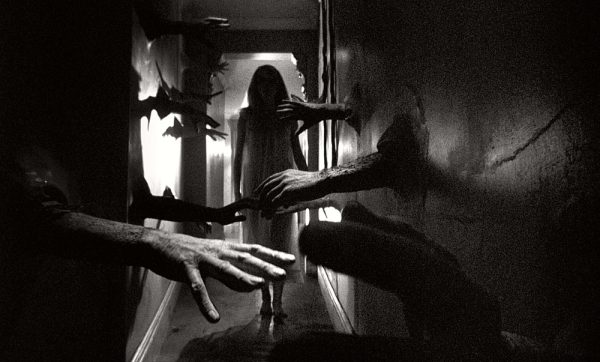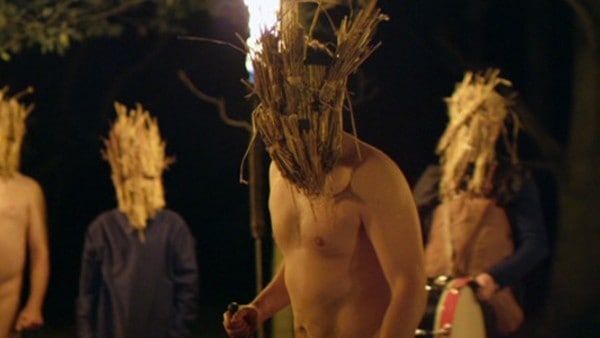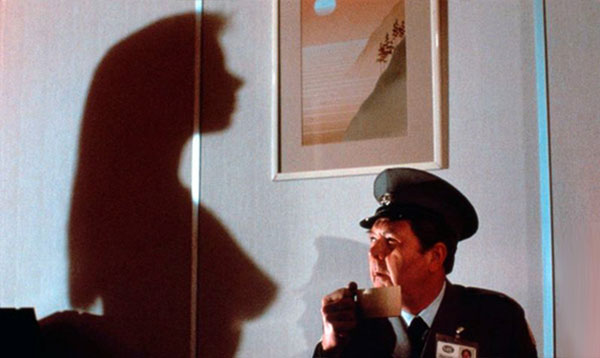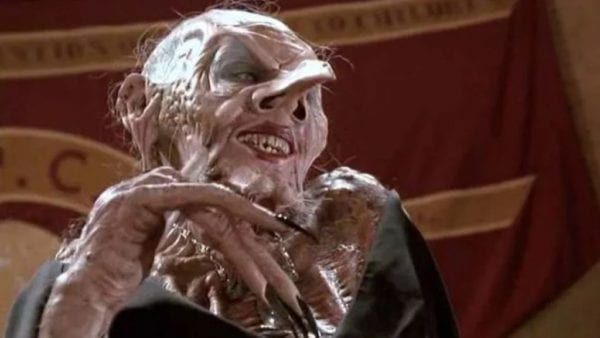Tom Jolliffe looks at ten essential British horror movies…

We love a good horror film at Flickering Myth (so much so that we’re releasing our very own, The Baby in the Basket, next month!). British cinema has produced many great horror films that are definitely inspiring and we’ve put together a list of essentials for you to check out. Grab your running shoes because there are zombies, cenobites and much more on your tail! Here are ten essential British horror films…
Don’t Look Now

Nicolas Roeg’s iconic psychological chiller is at once an enthralling meditation on grief and also an unnerving and foreboding tale of dangerous obsession. Though the film has ended up becoming iconic for its final act reveals as well as its controversial sex scene, it should be best remembered as the work of an exceptional director at his peak.
Roeg’s background in cinematography means his grasp on visual storytelling is strong and the film is beautifully lensed. The Venice locales definitely add to the eye-dazzling lure as do strong representations of colour (particularly red).
The greatest strength of the film lies in the performances of Donald Sutherland and Julie Christie whose respective dealings with grief are as enthralling as they are heartbreaking. It’s a stunning film that is still very powerful.
The Descent

After Dog Soldiers, Neil Marshall reaffirmed his place as a rising voice in British genre cinema with The Descent. It’s a simple concept, take a group of friends and have them go caving. Of course, though they have an expert among them, they’re also unprepared for emergency events and end up trapped in a series of caves.
Sadly for them, there’s a collection of human bat hybrid type creatures below ground that love nothing more than chomping on attractive female cavers. The best thing about Marshall’s film is that where this could have been treated a little trashy (and still been effective as a concept schlocker), he’s imbued it with interesting characters and repressed conflicts that come into play.
Above all, it’s a film that makes your skin crawl and it’s one of the most effective survival horrors of its era. Marshall has never lived up to this one, unfortunately, but still remains a solid exponent of genre films.
Repulsion

Roman Polanski brings Catherine Deneuve to London for this disturbing psychological horror. Polanski’s 60s-era horror films were an intriguing mix, particularly looking into aspects of gaslighting and trying to rationalise the irrational fear only to discover they are in fact rational.
The black and white cinematography has beautiful contrast and crisp noir shadows and Polanski uses the confined setting of a London apartment to good effect to really emphasise the isolation of the protagonist. The moveable sets, lengthening corridors and the paranoid delusions that include hands breaking through walls are all intense and disturbing.
None of this works, however, without a tour-de-force performance from Deneuve. She is unforgettable, as is the film.
Kill List

Ben Wheatley really put himself on the map with Kill List. Going in blind is best so maybe skip to the next selection if you’ve not seen the film…
Kill List begins as something of a crime thriller crossed with kitchen sink drama about a hit man with a breaking relationship, PTSD from a prior job and an inability to control his temper, brilliantly played by Neil Maskell.
Sent on a new assignment with the promise of life-changing money, he uncovers something far darker with a final act turn into folk horror that is shocking, unexpected and loaded with gruesome scares. It’s a film that threatens to lose you toward the end of Act 2 with meandering hitman exploits and the loose nature of the Brit Mumblecore dialogue, but then the rug pull happens and throws you into a different film entirely.
28 Days Later

Danny Boyle went rough and ready with this intense and visceral zombie film. From its unforgettable opening with Cillian Murphy in a desolate London to its grimy but propulsive finale, it’s a great exercise in concept and delivery over presentation.
Even shot on a Canon DV, there are still plenty of engaging visuals and that grain and roughness of the low res camera just seem to make the film that bit more gritty.
Murphy is great and there’s a fine supporting cast as you would normally expect from a Boyle film, not least Brendan Gleeson and Naomie Harris.
Hellraiser

Clive Barker transitioned from being one of the most exciting horror novelists of the 80s to becoming a cinematic visionary with Hellraiser. It’s the seat of the pants and bullish approach that tested his team to the very top of their capabilities like many newbie directors of the era coming from other disciplines.
What is delivered is a film of intriguingly dark psychological and psychosexual ideas, delving into sadomasochism and BDSM under the guise of fantasy horror. Interestingly, the film transitions protagonists, shifting our focus from the repressed housewife of a slightly oblivious cucked American husband to his daughter. Julia the stoic middle-aged wife, obsessed with her absent brother-in-law (Frank, a hedonist with an occult fascination) is the more interesting of the leading ladies, played with fiercely glared black widow sexuality by Clare Higgins.
Of course, the eponymous Pinhead became the franchise’s star and Doug Bradley, aided by the stunning Bob Keen make-up and design, is iconic. The score is also great.
Images

Robert Altman had an eclectic career, becoming more synonymous with his acerbically comic dramas. However, some of his earlier genre work remains essential, not least Images.
Susannah York plays an author who retreats to a remote country house in order to try and finish her book. There she increasingly struggles to distinguish reality from bouts of delusion. The quaint settings initially exude calm and tranquility but quickly switch to isolation and dread as York breaks down.
Images is full of memorable images and discomforting moments, powered by York’s stunning performance.
The Witches
Call this a kids film? Based on the classic tale by Roald Dahl, The Witches is a great version of Dahl’s brilliant story, perfectly conveying his dark humour and sense of anarchic fun.
Whilst it may be a kids’ film with all manner of kids’ film tropes and haphazard misadventures (such as when Luke is turned into a mouse, and an appearance by Rowan Atkinson), it’s never shy of getting dark. It used to terrify me as a kid, and still makes me shift in my seat to this day.
It’s partly thanks to some great villains, headed up with particular relish by Anjelica Huston and great creature make-up. It’s also due to that 80s and early 90s penchant for kids’ films to be directed by visionary directors of distinctly mature material. You had Mike Hodges of Get Carter directing Flash Gordon, Peter Yates directing Krull, Ridley Scott directing Legend, and of course Nic Roeg at the helm of this film.
Lifeforce

Cannon orchestrated a big budget sci-fi horror mesh in the UK, in a way only Cannon could. It’s a mash up of Alien and vampire lore with a heavy sprinkle of exploitation. It might be Cannon and in some aspect a budget version of the big studio spectaculars, but the film is still loaded with some great effects and bolstered by an awesome score from Henry Mancini (the main cue you’ll have heard on countless late 80s/early 90s trailers).
There’s a veritable who’s who of British actors in the cast, most notably Peter Firth and Patrick Stewart but among all the gravitas and the impressive visual effects, perhaps the greatest special effect in the film is Mathilda May who plays the space vampire. One of the most iconic queens of Cannon cinema, May spends the vast majority of the picture with nothing on, and yet oddly, it doesn’t feel entirely gratuitous with her space vamp being a variation on the siren and selkie myths.
The Blood on Satan’s Claw

Before Golan and Globus acquired the company, Cannon Films were more renowned for quainter folk horror and indie dramas, with the odd dive into exploitation before the go-go boys came in and focused more intensely on trash cinema to begin with.
The Blood on Satan’s Claw is a classic Brit horror that sees a group of kids getting in over their heads, and in danger of invoking Satan. It feels somewhere between Hammer and Corman, full of gothic atmosphere and dread. At the same time, it carries all the melodramatic, slightly campy hallmarks of Hammer with Patrick Wymark in particular hamming it up to the hilt. It’s great fun and probably prime material for a more serious A24-esque modern reboot.
What’s your favourite British horror film? Let us know on our social channels @FlickeringMyth or hit me up @jolliffeproductions…


